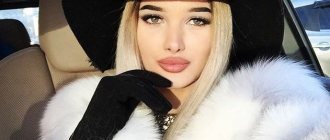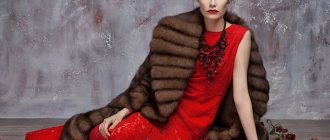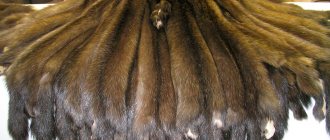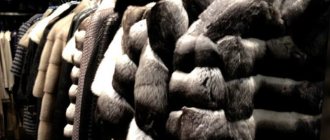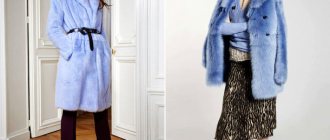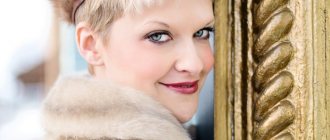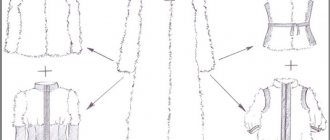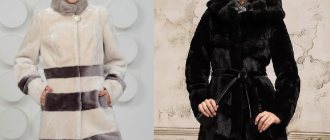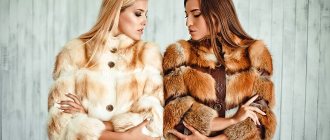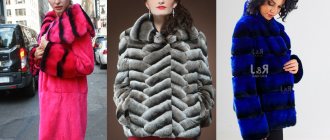Fur coats made from natural sable fur have always been popular among the fairer sex. Moreover, both young girls and older women showed love for such products equally. But none of the fashionistas ever thought about the number of natural skins that are required to sew one luxurious fur coat. But it’s interesting to know how craftsmen calculate the required amount of fluffy material for sewing a product of medium length.
Mink coat
How many skins are required?
To calculate the required amount of material, you need to know what type is used and its possible sizes. The fur most often in demand is mink, chinchilla, badger, raccoon, fox, and squirrel.
The following information is not for animal activists. According to statistics, data on how many fox skins are needed for a fur coat are averaged to the number 8. How many skins are needed for a chinchilla fur coat if they are significantly smaller than a fox? This figure is much higher - about 160, and sometimes more. Data for all the most common types of fur are also averaged. To sew a knee-length product you need: 60 sables, 20 beavers, 25 otters, 55 minks, 200 squirrels, 27 raccoons, 5 wolves, 8 seals, 60 martens, 15 lynxes, 135 chinchillas, 50 ferrets, 11 badgers, 30 muskrats, 125 ermines.
How to calculate the required footage for sewing the desired fur coat?
In order to calculate the correct footage for sewing a fur coat, you need to take into account several parameters:
1. Product length. Determined from the top point of the shoulder to the desired length of the product.
2. Sleeve length. Determined from the shoulder point to the desired sleeve length.
3. Product type. If the fur coat is supposed to have a straight or slightly flared silhouette, then with the width of the fur fabric (147-150 cm) from size 42-48, one length of the product will be sufficient. If the size is more than 50 and above, you will need two lengths of the product. Also, if the fur coat is supposed to have a very flared silhouette or a wrap, then in this case, two lengths of the product will be required for any size.
4. The presence of such structural details as a collar, hood, belt will also require additional footage of fur fabric. Approximately from 0.5 m-0.8 m, taking into account individual wishes for the proportions of the parts themselves. Fur coats are rarely trimmed. More often, the lining with or without insulation is cut out right to the edge of the side, and the fur is tucked in. Less common is a narrow brim, for example, made of suede. If the lining is made of the main fabric, then it is better that it is one-piece - there are fewer seams. Details such as patch pockets usually do not require additional footage, since they can be cut out from the lunges during the general cutting of the product.
5. Allowances for processing seams, shrinkage of the fabric (in the case of a knitted base). Approximately from 10-20 cm.
6. Combination of fur. If some parts of the product are supposed to be made from different types of fur, then the footage for each part is calculated separately. When calculating, the height of the part is usually taken.
What related materials will also need to be included when sewing a fur coat:
1. Lining fabric. The required yardage of lining fabric requires only two values: product length + sleeve length. Recommendation: for the most comfortable wearing of a fur coat, it is recommended to choose lining fabrics with 100% viscose content (twill). It is better not to use a synthetic composition to avoid the formation of a static discharge.
2. Insulating material (if you want to further insulate your fur coat). You can buy special insulation for eco-fur coats from us: Insulation
Recommendation: any insulation with windproof impregnation insulates the product without giving it additional volume. You can also use an insulating lining made of 100% wool. For example, soft woolen knitwear or soft cloth are perfect as a warm lining.
3. Accessories. The choice of buttons, hooks and other decorative details is an individual choice and has no special recommendations.
Table: fur and approximate amount of whole skins
We have compiled a table with popular types of fur from which fur coats are made. Then they called the fur studio and asked questions about the number of certain animals for a fur coat for a slender girl weighing 55 kg and 180 cm tall.
And this is what we got. The variation depends on many nuances - for example, height and physique, product model and length. For example, to the knees or below, with or without a hood.
| Fur | Number of skins |
| Mink | from 25 to 45 |
| Marten | from 25 to 60 |
| Silver fox | from 25 to 30 |
| Chinchilla | from 150 to 250 |
| Sable | from 70 to 90 |
| Lynx | from 12 to 20 |
| Arctic fox | from 12 to 18 |
| Nutria | from 45 to 75 |
| Fox | from 20 to 35 |
| Beaver | from 40 to 55 |
| Rabbit | from 50 to 100 |
| Raccoon | from 35 to 45 |
| Otter | from 50 to 75 |
| Astrakhan | from 45 to 65 |
Lamb fur coat
To sew a beautiful fur coat from lamb fur, you will need to trim 20-30 animals, depending on their size. To sew a product slightly below the hip length - 16-18 skins. A short sheepskin coat will be made from 8-10 skins of young lambs. What does a young lamb fur coat look like? This is the well-known astrakhan fur, which stands out from other furs with its original curls of curls located throughout the trim. To produce products, craftsmen use the fur of three-day lambs. It is at this age that the stuffing is distinguished by its softness.
Otter skins
What is the advantage of an astrakhan fur coat made from whole pieces of fur? This product is warm, wearable and durable. In the color range, astrakhan fur is presented in black, white, gray and brown. Craftsmen recommend using the dressing of Afghan lambs for sewing fur coats. This material is the warmest and most durable. With average financial capabilities, you can give preference to Uzbek karakul. It costs less than the Afghan one, but is not inferior to the first in terms of durability and strength.
Fur dressing
We will learn from the video how to correctly calculate the required number of skins for sewing a medium-length fur coat.
Table of the number of skins for different types of fur coats
| Fur coat type: | Approximate number of skins |
| Astrakhan | 50 |
| Otter | 60 |
| Rabbit | 70 |
| Raccoon | 40 |
| Beaver | 50 |
| Fox | 30 |
| Mink | 40 |
| Silver fox | 30 |
| Marten | 40 |
| Chinchilla | 170 |
| Sable | 80 |
| Lynx | 15 |
| Nutria | 50 |
| Arctic fox | 15 |
Mink
How many mink skins do you need for a fur coat? To correctly calculate the required material, in this case mink skins, you need to know the length and style of the planned model. If the model is shortened, then less, if extended, then more. The number of skins is influenced by the size of the animal itself and the quality of the fur. It is important that there are no defects on it. You will need more females than males as they are shorter.
Fur coats with more skins are valued higher. If 40 male skins are needed, then female representatives need 2 times less.
If the customer chooses a product design option with a collar, the quantity will be increased. The same procedure is performed when adjusting product sizes and taking into account the style.
A new thing made from mink will please its owner for many years, but to create your own fur coat, you need to count on financial investments. The described necessary parameters give an idea of the labor intensity of the manufacturing process of such clothing, the selection of high-quality raw materials, which is reflected in the final amount to be paid.
Rabbit
How many rabbit skins do you need for a fur coat? When selecting rabbit skins, you should also pay attention to the gender of the animal. Males, like minks, are much larger than females and have a richer fur color. Females have another advantage: their fur is softer, more delicate, and color transitions occur smoothly.
Thus, to sew a fur coat from rabbit skins, you need an average of 27 skins of large rabbits (for a medium-length model of the classic style, size 42). When choosing a loose cut or longer length, you need to add some skins.
Modern techniques for processing and sewing fur products allow you to create attractive models. If earlier fashionistas may not have paid attention to such products, now they are happy to buy them. Designers have liked this kind of fur for a long time. He is not only beautiful, but also pleasant to work with.
Such fur can be easily dyed and processed using various textile methods. Fashion seasons are not complete without new products using this fur. The couturiers surprise not only with fresh design solutions, but also boldly use different decor (pleating, wedges, flounces). It is true that you can play with rabbit fur, changing not only the color, but also imitating other types of fur. Of course, many ideas require more raw materials, and this also needs to be taken into account. When calculating the required number of rabbit skins, both the size of the skins and the features of the cut are taken into account. The availability of fur is encouraging; it is not expensive, but attention is paid to some of the features described above, and the combined factors determine the cost of the product.
You can also calculate how many sable skins are needed for a fur coat or how many beaver skins are needed for a fur coat, using similar criteria.
A larger amount of material, its high cost, the complexity of processing and selection of colors, and the elimination of defects cannot influence the reduction in the cost of a fur coat.
Video review
To get a quality product, you need to carefully approach the manufacturing process. It is better if you turn to specialists at a fur salon for help. They will tell you what is the best thing to do in order to please yourself with a worthy new thing for the optimal amount.
Leave your comment:
Facts about natural fur coats
Mink or sable skin has always been valued among fashionistas. At all times, natural products were sold for a high price, which was justified by their impeccable quality. Outerwear made of natural fur retains heat perfectly and retains its attractive appearance for a long time. Fashionistas are also attracted by the beautiful color scheme, which cannot be reproduced artificially. Natural fur shimmers in beautiful shades in the sun.
Arctic fox fur coat
If we talk about sable fur, it is naturally black, grayish and white. The rarest and most expensive is white fur. Barguzin sable fur is also expensive. Mink dressing is no less popular. Often used for sewing fur coats of different lengths and styles.
Colored mink
What do you need to sew a fur coat with your own hands?
The main thing is the material for work:
- Natural fur can be purchased in specialized stores or from hunters in the form of individual skins. Working with this material requires certain specialized knowledge and is one of the most difficult areas in sewing.
- Faux fur can be found in almost any fabric store. Working with it is much easier than with its natural analogue. This material is much cheaper in price, and it is not so scary to spoil it; it is sold in the form of a single piece, like regular fabric.
- Old fur fabrics, for example in the form of a fur coat and vest, which can be converted into a new fur coat. In this case, you need to understand that if there are abrasions and unsightly places on the material, they will have to be removed.
- Lining material. Satin or satin is often used as a lining for a fur coat; they are usually inexpensive. The product is given a rich look due to its smooth shiny surface, and these materials are very wear-resistant and retain their shape well during use.
In addition to the material itself, to create a fur coat with your own hands you will need the following equipment:
- Tailor's sharpened scissors or furrier's knife, the second option is preferable when working with natural fur.
- Clothespins are also needed for working with natural fur.
- Hammer with a soft silicone head or wrapped in cloth.
- Chalk, soap or gel ballpoint pen in a bright color.
- Metal long ruler.
- Safety pins.
- Small nails (when working with natural fur).
- Tape measure.
- A punch for installing accessories and attachments for it.
- Furrier's needles for machines, having three edges or gypsy needles.
- Comb.
- Thimble.
- The fittings are decorative and functional.

